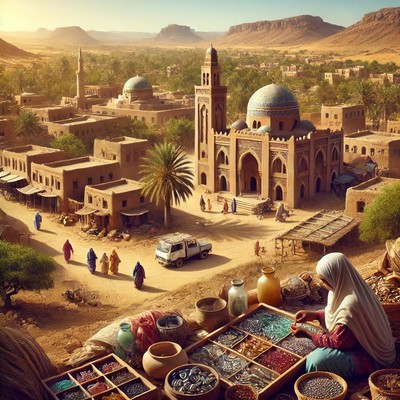Mauritania
TOUR IN
$4300
per person
Availability: 10 places
This Tour Has Been Planned But Dates Are Not Yet Definite And Due To Remote Location. Itinerary Is Subject To Change . The Itinerary Can Also Be Personalized And Tailored To A Small Group. DO NOT BOOK NOW .CONTACT US DIRECTLY travel@
Mauritania’s vast desert landscapes and remote towns make travel an adventure, requiring a mix of patience, preparation, and flexibility. Here’s how to navigate the country:
1. By Air
Mauritania has limited domestic flights. Nouakchott (NKC) and Nouadhibou (NDB) are the main international airports, but domestic air travel is rare. Most journeys across the country are done by land.
2. By Road
-
Buses & Shared Taxis:
- Companies like Sonef and Al-Moussavir run buses between major cities, including Nouakchott, Nouadhibou, Atar, and Kiffa.
- Shared taxis (old Mercedes or Peugeots) are common but can be cramped. They leave when full, so schedules are unpredictable.
- Roads between major towns are paved, but many routes, especially in the desert, require 4x4 vehicles.
-
Car Rental & 4x4 Travel:
- Renting a 4x4 with a driver is recommended for remote areas like Chinguetti, Ouadane, or the Banc d’Arguin National Park.
- Self-driving is possible but requires experience with desert navigation and a good GPS. Fuel stations can be sparse.
3. By Train (Iron Ore Train)
- One of the most famous ways to experience Mauritania is by riding the Iron Ore Train, one of the longest trains in the world.
- It runs daily from Nouadhibou to Zouérat, carrying iron ore and passengers.
- Travelers can ride in the empty ore wagons for free (but expect a tough, dusty ride) or opt for a ticketed spot in the small passenger car.
4. By Boat (Limited Use)
- Boat travel is minimal, but fishermen offer short rides along the Atlantic coast near Banc d’Arguin.
- The Senegal River, bordering Senegal, has some local pirogues (canoes) but is not a major transport route.
Important Travel Tips
- Border Crossings: Main land crossings are with Senegal (Rosso and Diama), Morocco (via Western Sahara), and Mali. The border with Algeria is closed.
- Permits & Checkpoints: Expect police checkpoints where you may need to show identification or fiche (a printed copy of your passport details).
- Desert Travel Precautions: Carry extra fuel, water, and supplies if heading into the desert. Hiring a local guide is advisable for remote areas.
Traveling in Mauritania requires an adventurous spirit, but with preparation, it offers some of the most spectacular and unique experiences in West Africa.
Day 1
Nouakchott
Nouakchott, the capital of Mauritania, is a sprawling city where the desert meets the Atlantic. Though not as touristy as other capitals, it offers a unique blend of local culture, markets, and coastal life. Here are the top things to do:
1. Port de Pêche (Nouakchott Fishing Port)
- One of the most vibrant spots in the city, this port is a must-visit.
- Watch hundreds of colorful wooden fishing boats (pirogues) bring in their daily catch.
- Experience the chaos of fishermen hauling in fish and women bargaining at the bustling market.
- Best time to visit: Late afternoon when boats return with their catch.
2. Nouakchott Beach
- A wide, windswept beach perfect for a stroll or relaxing by the ocean.
- See local fishermen at work or take a camel ride along the shore.
- Though the water can be rough, it’s a great spot to enjoy the sunset.
3. Marché Capitale (Central Market)
- The heart of local commerce, offering everything from fabrics and spices to electronics.
- A great place to experience daily Mauritanian life and practice your bargaining skills.
- Be prepared for a lively and sometimes chaotic atmosphere.
4. Marché aux Khaïmas (Tent Market)
- Specializes in traditional Mauritanian items like handmade carpets, silver jewelry, and desert-style clothing.
- A great place to buy a daraa (traditional Mauritanian robe) or a turban.
5. Saudi Mosque
- One of Nouakchott’s most prominent landmarks, funded by Saudi Arabia.
- Beautiful Islamic architecture and a peaceful atmosphere.
- While non-Muslims cannot enter, it’s still worth admiring from the outside.
6. National Museum of Mauritania
- Offers insight into the country’s history, archaeology, and nomadic culture.
- Features artifacts from ancient Saharan civilizations and displays on Mauritanian traditions.
- Though small, it provides a good introduction to the country’s heritage.
7. Banc d’Arguin National Park (Day Trip Option)
- Located a few hours north of Nouakchott, this UNESCO-listed park is a paradise for birdwatchers.
- Home to thousands of migratory birds, including flamingos and pelicans.
- The park also offers a chance to meet the local Imraguen fishermen, who still use traditional techniques.
8. Tea Culture & Local Cuisine
- Join locals for a glass of Mauritanian mint tea, an essential part of daily life.
- Try local dishes like Thieboudienne (fish and rice), Mechoui (roast lamb), or Mahfe (peanut stew).
- Recommended local restaurants: Chez Zaza, Iman Restaurant, and Le Frisco.
9. Ksar Neighborhood
- One of the oldest districts in Nouakchott, where you can see a more traditional side of the city.
- Features small markets, local eateries, and a glimpse into everyday life.
Nouakchott may not have a long list of tourist attractions, but it offers a raw and authentic experience for travelers interested in culture, local markets, and life by the Atlantic.

Day 2
Nouadhibou
Nouadhibou, the second-largest city in Mauritania, is a key fishing hub and a gateway to some of the country’s most fascinating coastal and desert landscapes. Located on a peninsula near the border with Western Sahara, the city offers a mix of maritime culture, abandoned shipwrecks, and remote natural beauty.
1. The Shipwreck Graveyard
- Nouadhibou was once home to one of the world’s largest ship graveyards. While many wrecks have been removed, some still remain along the coastline.
- You can spot rusting vessels along the shore near Cansado and Cap Blanc.
- Hiring a local guide or fisherman may help you reach some of the more hidden wrecks.
2. Cap Blanc (Cabo Blanco) Nature Reserve
- A dramatic headland known for its stunning coastal views and diverse wildlife.
- Home to one of the last remaining colonies of Mediterranean monk seals.
- The area also has an old Spanish lighthouse, adding to its historical charm.
- Bring binoculars for birdwatching, as seabirds are common in the area.
3. Banc d’Arguin National Park (Day Trip Option)
- Located south of Nouadhibou, this UNESCO World Heritage site is a paradise for birdwatchers.
- The park is home to thousands of migratory birds, including flamingos, pelicans, and terns.
- Visit the Imraguen fishing communities, who still use traditional fishing techniques with dolphins.
- A 4x4 and a local guide are recommended to access the park.
4. Nouadhibou’s Fishing Port & Market
- The city’s economy revolves around fishing, making the port a fascinating place to explore.
- Watch fishermen unload their catch and see how the local fish trade operates.
- Visit the lively fish market, where you can buy fresh seafood or simply observe the hustle and bustle.
5. The Iron Ore Train
- Nouadhibou is the starting point of the famous Iron Ore Train, one of the longest and heaviest trains in the world.
- You can ride in an open ore wagon for a raw, adventurous experience, or book a spot in the passenger car.
- The train journey from Nouadhibou to Choum (or Zouérat) is a once-in-a-lifetime adventure through the Sahara.
6. Baie du Lévrier (Levrier Bay)
- A stunning coastal area with scenic views, sand dunes, and calm waters.
- Great for a quiet walk or a picnic by the sea.
- Some parts of the bay offer good fishing spots.
7. Visit Cansado (The Old Spanish Quarter)
- A small residential area originally built for Spanish workers.
- Has an old, colonial feel with a mix of modern and abandoned buildings.
- A quiet place to explore and get a glimpse of Nouadhibou’s past.
8. Try Local Seafood
- Nouadhibou has some of the freshest seafood in Mauritania.
- Popular local dishes include grilled fish, shrimp, and Thieboudienne (Mauritanian fish and rice).
- Recommended spots: Restaurant Jambalaya, Le Prince, and La Sirène.
9. Border Crossing to Western Sahara
- If you're traveling overland to Morocco, Nouadhibou is the last major stop before crossing into Western Sahara at Guerguerat.
- The journey involves a no-man’s land that is rough and requires a 4x4 for safe passage.
- Be prepared for checkpoints and border formalities.
Nouadhibou is a fascinating mix of maritime culture, desert adventure, and remote coastal beauty. Whether you're exploring shipwrecks, watching seals, or riding the Iron Ore Train, the city offers a unique experience off the beaten path.
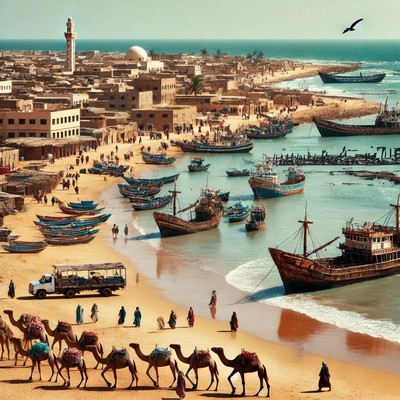
Day 3
Chinguetti
Chinguetti, one of Mauritania’s most iconic destinations, is an ancient Saharan city that was once a major center of Islamic learning and a vital stop for trans-Saharan caravans. Today, it remains a UNESCO-listed treasure, with its stone-built architecture, timeless desert atmosphere, and rich cultural heritage. Here’s what to do when visiting Chinguetti:
1. Explore the Ancient Libraries of Chinguetti
- Chinguetti is home to some of the oldest Islamic manuscripts in the world.
- The Ancient Libraries of Chinguetti house rare books on astronomy, religion, mathematics, and poetry, some dating back nearly 1,000 years.
- Notable libraries include Bibliothèque Habott and Bibliothèque Al-Ahmed Mahmoud, where caretakers explain the history of these texts.
2. Visit the Chinguetti Mosque
- One of Mauritania’s most iconic landmarks, featuring a square minaret made of stone.
- Considered the seventh holiest site in Islam, though non-Muslims are not allowed inside.
- Its simple yet striking architecture, set against the backdrop of the desert, makes it one of the most photographed sites in the country.
3. Wander Through the Old Town
- Walk through the narrow alleys and admire the stone-built houses and sand-covered streets.
- Experience the timeless atmosphere of a town that has remained largely unchanged for centuries.
- Interact with locals and hear stories about Chinguetti’s past as a major Saharan trading hub.
4. Camel Trekking into the Sahara
- The rolling dunes of the Erg Warane desert surround Chinguetti, making it a perfect place for camel trekking.
- Take a short ride into the dunes for sunset, or embark on a multi-day desert excursion.
- Guided camel treks can be arranged through local guides, often including tea with nomadic families.
5. Experience a Traditional Tea Ceremony
- Mauritanian mint tea is a central part of local hospitality.
- Join a tea ceremony with locals, where the tea is poured high into small glasses to create foam.
- A great way to experience Mauritanian culture and take a break from exploring.
6. Visit the Sand Dunes at Sunset
- Climb the nearby dunes to watch the sun set over the Sahara.
- The landscape turns golden and orange, creating a magical experience.
- Best spots include the dunes just outside the old town.
7. Stargazing in the Desert
- Chinguetti, far from modern light pollution, is an ideal place for stargazing.
- On a clear night, you can see thousands of stars, including the Milky Way.
- Local guides can arrange desert camping trips, where you can sleep under the stars.
8. Visit the Oasis of Terjit (Day Trip Option)
- Located about 50 km south of Chinguetti, Terjit is one of Mauritania’s most beautiful oases.
- Lush palm groves and natural freshwater pools provide a refreshing break from the desert.
- You can relax in the shade, take a dip in the water, and enjoy the peaceful atmosphere.
9. Learn About Chinguetti’s History at the Cultural Center
- Some local cultural centers and guides offer insights into the history of Chinguetti’s role as a caravan hub.
- Learn about the ancient trade routes, religious scholars, and the decline of the once-great Saharan city.
10. Take a 4x4 Adventure to Ouadane or the Eye of the Sahara
- If you’re up for a desert road trip, drive to Ouadane, another ancient Saharan town with stunning ruins.
- Visit the Richat Structure (Eye of the Sahara), a massive circular geological formation visible from space.
- A 4x4 is necessary for these trips, and hiring a local guide is highly recommended.
Final Thoughts
Chinguetti is not just a destination; it’s an experience. From its ancient libraries and stone mosques to the golden dunes and star-filled skies, it offers a glimpse into a world where history and nature merge. Whether you’re exploring centuries-old manuscripts, riding camels into the Sahara, or sipping tea with locals, Chinguetti is a must-visit for travelers seeking adventure and cultural immersion in Mauritania.
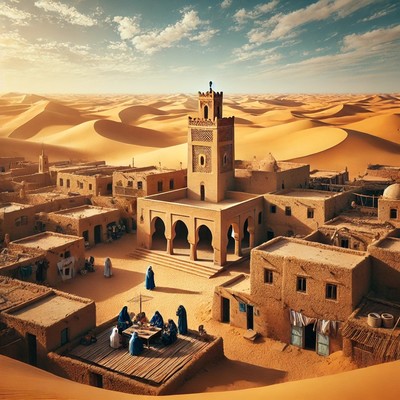
Day 4
Ouadane
Ouadane is one of Mauritania’s most fascinating historical towns, located deep in the Sahara. Once a thriving caravan center along trans-Saharan trade routes, it now stands as a UNESCO-listed ghost town, rich with history, unique desert landscapes, and access to one of the world’s most mysterious natural wonders—the Eye of the Sahara.
1. Explore the Ancient Ruins of Ouadane
- Wander through the stone ruins of the old city, built in the 12th century.
- Discover abandoned houses, crumbling walls, and winding alleys that tell the story of a once-flourishing trade hub.
- Visit the Old Mosque, a historic landmark with an iconic square minaret.
- The best time to visit is early morning or late afternoon when the light creates beautiful contrasts on the stones.
2. Visit the Eye of the Sahara (Richat Structure)
- One of the world’s most mysterious geological formations, visible from space.
- Located about 45 km from Ouadane, it appears as a massive, concentric ring-like structure in the desert.
- Scientists believe it was formed by erosion, but its exact origins remain debated.
- A 4x4 vehicle and an experienced guide are necessary to reach the site.
3. Walk Through the Modern Town of Ouadane
- The new town, located next to the ancient ruins, offers a glimpse into modern desert life.
- Meet locals, explore small markets, and experience traditional hospitality.
- A great place to sip Mauritanian mint tea and listen to stories about the town’s history.
4. Visit the Ouadane Museum
- A small but interesting museum showcasing artifacts from Ouadane’s history.
- Displays include ancient coins, trade goods, and historical documents.
- Offers insight into the role Ouadane played in Saharan trade routes.
5. Experience a Desert Sunset from the Ruins
- The ruins of Ouadane offer one of the best sunset views in Mauritania.
- Climb to a higher point among the ruins to watch the sun set over the Sahara.
- The colors of the sky and the golden hue on the stone walls create a magical scene.
6. Camel Trekking & Desert Excursions
- Embark on a camel trek into the surrounding desert, following the footsteps of ancient traders.
- Multi-day treks can take you to remote nomadic settlements and hidden oases.
- A perfect way to experience the silence and vastness of the Sahara.
7. Discover Ancient Rock Carvings (Petroglyphs)
- Near Ouadane, you can find ancient rock carvings that date back thousands of years.
- These petroglyphs depict animals, warriors, and daily life from a time when the Sahara was greener.
- Ask local guides for directions, as they are located off the beaten path.
8. Visit the Fortified Granaries
- In the past, Ouadane’s traders used fortified stone granaries to store grains and goods.
- Some remnants of these structures can still be seen today.
- A reminder of Ouadane’s strategic importance as a trading and storage center in the Sahara.
9. Stargazing in the Desert
- With almost no light pollution, Ouadane is a perfect place for stargazing.
- On clear nights, you can see the Milky Way, constellations, and shooting stars.
- Desert campsites near the town offer overnight stays with local nomads under the stars.
10. Take a 4x4 Trip to Chinguetti
- If you haven’t already visited, Chinguetti is another ancient Saharan town located about 130 km from Ouadane.
- Famous for its Islamic libraries, desert dunes, and historical architecture.
- A great combination with an Ouadane trip for those exploring the Adrar region.
Final Thoughts
Ouadane is one of Mauritania’s most rewarding travel destinations, offering a mix of ancient history, desert landscapes, and unique natural wonders. Whether you're exploring the ruins of a lost city, visiting the Eye of the Sahara, or trekking into the dunes, this remote town offers a true adventure into the heart of the Sahara.
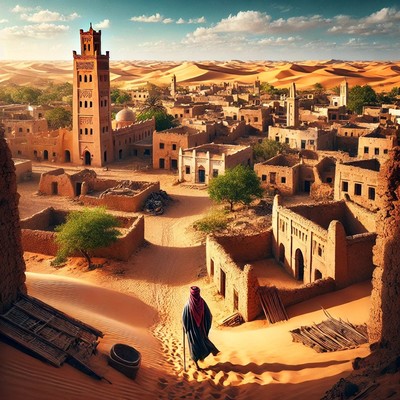
Day 5
Banc d’Arguin National Park
Banc d’Arguin National Park, a UNESCO World Heritage Site, is one of Africa’s most important wildlife reserves, located along Mauritania’s Atlantic coast. The park is a paradise for birdwatchers, nature lovers, and eco-tourists, offering a unique blend of desert, wetlands, and marine ecosystems. Here’s what you can do in this remote and stunning natural wonder:
1. Birdwatching – A Paradise for Migratory Birds
- Banc d’Arguin is one of the best birdwatching spots in the world.
- Home to millions of migratory birds, including:
- Flamingos
- Pelicans
- Terns and gulls
- Herons and spoonbills
- Ospreys and other raptors
- Peak birdwatching season: November to March, when birds from Europe and Siberia migrate south.
- The park is best explored with a boat trip to the bird colonies on offshore islands.
2. Explore the Imraguen Fishing Villages
- The Imraguen people are traditional fishermen who have lived in the area for centuries.
- They practice a unique form of fishing with dolphins, where wild dolphins help drive fish toward their nets.
- Visit their villages, such as Iwik, R’Gueiba, and Teichott, to learn about their sustainable fishing techniques and lifestyle.
- Some villages offer basic eco-lodges, allowing travelers to stay overnight.
3. Take a Traditional Fishing Trip
- Join the Imraguen fishermen on their boats and watch how they work with dolphins to catch fish.
- Learn about their handmade wooden pirogues (boats) and traditional net fishing techniques.
- Some local fishermen allow visitors to participate in their daily fishing routines.
4. Boat Tours & Island Hopping
- The park includes several small islands that serve as bird nesting sites.
- A guided boat tour takes you through the mangroves, sandbanks, and shallow waters to explore these islands.
- Possible islands to visit:
- Nair Island – A major bird nesting site.
- Zira Island – Surrounded by rich marine biodiversity.
- Boats depart from the Imraguen villages and must be arranged in advance.
5. Spot Marine Life and Desert Wildlife
- The park is not just about birds—its waters are home to a rich marine ecosystem.
- You may spot:
- Dolphins (often near fishing villages)
- Sea turtles
- Mullet fish and other marine species
- On land, keep an eye out for fennec foxes, jackals, and desert gazelles.
6. Walk Along the Untouched Beaches
- Banc d’Arguin’s coastline features long, pristine beaches with golden sands.
- Unlike more developed beach destinations, these shores are wild, remote, and completely untouched.
- Enjoy the solitude, take photographs, or just relax by the Atlantic waves.
7. Camping in the Park
- Eco-camps and guesthouses are available in some Imraguen villages.
- Camping under the stars offers an authentic experience in the remote wilderness.
- Nights in the park are peaceful, with clear views of the Milky Way due to zero light pollution.
8. Experience the Sahara Meeting the Sea
- Banc d’Arguin is where the Sahara Desert meets the Atlantic Ocean.
- The contrast between towering sand dunes and blue waters is breathtaking.
- Explore the coastal dunes and salt flats, shaped by desert winds and ocean tides.
9. Visit Cape Tafarit and Cape Timiris
- These coastal headlands provide excellent viewpoints over the Atlantic.
- A great spot for photography, especially at sunrise and sunset.
10. Discover the Cultural Significance of the Park
- Banc d’Arguin has been a key trading and fishing area for centuries.
- Learn about the archaeological sites and ancient settlements in the region.
- Some local guides provide historical insights into the Berber, Arab, and Imraguen influences on the area.
How to Visit Banc d’Arguin
- The park is remote, and visiting requires a 4x4 vehicle.
- Main entry points: Nouadhibou (to the north) or Nouakchott (to the south).
- Guided tours are highly recommended, as local guides know the best spots for wildlife and cultural experiences.
Final Thoughts
Banc d’Arguin is a hidden gem in Mauritania, offering an incredible mix of wildlife, cultural traditions, and untouched nature. Whether you’re spotting flamingos, watching dolphins work alongside fishermen, or camping under the stars, this park provides a once-in-a-lifetime eco-adventure in one of Africa’s most remote coastal landscapes.

Day 6
Tichit
Tichit is one of Mauritania’s most remote and historically significant towns. A UNESCO-listed settlement, it was once an important stop along the trans-Saharan trade routes, known for its unique red sandstone architecture and rich Islamic heritage. Located deep in the Tagant region, Tichit offers a rare opportunity to explore an ancient caravan town untouched by modernity.
1. Wander Through the Old Town (UNESCO Heritage Site)
- Tichit’s old town is one of the best-preserved medieval Saharan settlements.
- Known for its unique red and yellow sandstone buildings, giving it a distinctive look.
- Explore narrow alleys, ancient stone houses, and old granaries that once stored trade goods.
- Some homes feature intricate geometric patterns on their facades, a rare architectural style in the Sahara.
2. Visit the Great Mosque of Tichit
- One of Mauritania’s oldest and most significant mosques, built in the 12th century.
- Made from local red and yellow stone, blending perfectly with the desert landscape.
- Though non-Muslims cannot enter, visitors can admire the beautiful architecture from outside.
3. Discover Tichit’s Ancient Libraries
- Tichit was a center of Islamic scholarship, and some of its ancient manuscripts still survive.
- The Tichit Library contains rare texts on astronomy, religion, mathematics, and medicine.
- These books, many centuries old, were once part of a vast knowledge network across the Sahara.
4. Explore the Ruins of Old Caravan Houses
- Many of Tichit’s ruins date back to the town’s golden age as a caravan hub.
- Merchants from Timbuktu, Morocco, and Sudan once traded here.
- Walk through the remains of old merchant houses, imagining how life thrived in this once-bustling town.
5. Hike to the Tagant Plateau
- Tichit is surrounded by the rugged Tagant Plateau, a vast landscape of cliffs and desert plains.
- Hike or take a 4x4 drive to scenic viewpoints overlooking the desert.
- The plateau offers breathtaking sunrise and sunset views over the sands.
6. Meet the Local Nomads
- The area around Tichit is home to nomadic tribes who still live traditional desert lifestyles.
- Experience authentic Mauritanian tea ceremonies in a Bedouin-style tent.
- Learn about nomadic survival techniques, camel herding, and desert crafts.
7. Visit the Ancient Wells of Tichit
- Water has always been crucial for survival in Tichit.
- Some ancient stone wells built centuries ago are still in use today.
- Locals can explain how these wells supported caravans and settlers in this harsh environment.
8. Camel Trekking & Desert Exploration
- Take a camel trek into the surrounding desert, just like ancient traders once did.
- Visit remote oases and sand dunes near the town.
- Spend a night in the desert under the clear, star-filled sky.
9. Experience Tichit’s Annual Festival (If You Time It Right!)
- Tichit occasionally hosts cultural festivals celebrating its history and traditions.
- Events include traditional music, poetry, and desert horse/camel races.
- These gatherings attract locals from across Mauritania and offer a rare insight into Saharan culture.
10. Visit Ksar El Barka (Day Trip Option)
- About 50 km from Tichit, Ksar El Barka is another ancient caravan town in ruins.
- Known for its fortified granaries and medieval-style buildings.
- A lesser-visited but fascinating site for those interested in desert archaeology.
How to Get to Tichit
- Tichit is one of the most isolated places in Mauritania, requiring serious planning to visit.
- Accessible only by 4x4 vehicles, usually from Tidjikja or Nema.
- The journey can take several days through rough desert terrain.
- Hiring a local guide and driver is highly recommended due to difficult road conditions.
Final Thoughts
Tichit is a hidden treasure of the Sahara, perfect for travelers seeking history, adventure, and deep cultural immersion. Whether you’re exploring ancient ruins, walking through red sandstone streets, or trekking into the desert, a trip to Tichit offers an authentic and unforgettable experience in Mauritania.
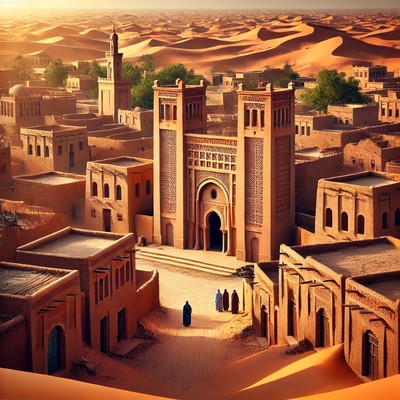
Day 7
Tidjikja
Tidjikja is the capital of the Tagant region, a remote but historically rich town known for its oases, stunning desert landscapes, and ancient caravan history. Founded in the 17th century, it was an important stop for trans-Saharan traders. Today, Tidjikja offers a quiet, off-the-beaten-path experience with a mix of history, culture, and desert adventure.
1. Explore the Old Town of Tidjikja
- Walk through the old stone houses, many built in traditional Saharan style.
- Some homes feature intricate geometric patterns carved into their facades.
- A great place to experience the authentic charm of an old desert town.
2. Visit the Mosque of Tidjikja
- The town’s main mosque is a simple but elegant structure, reflecting Saharan architecture.
- Although non-Muslims cannot enter, it is worth admiring from the outside.
- Its mud-brick and stone design blends beautifully with the surrounding desert.
3. Discover the Oasis of Lekcheb
- Located just outside Tidjikja, Lekcheb Oasis is one of the most beautiful in Mauritania.
- Lush palm groves and natural springs provide a refreshing escape from the desert heat.
- Perfect for a picnic, a short hike, or simply relaxing in the shade.
4. Explore the Tagant Plateau
- The Tagant Plateau is a rugged and scenic desert region surrounding Tidjikja.
- Features cliffs, rocky outcrops, and vast sand dunes.
- Best explored by 4x4 or on foot, with spectacular views at sunrise and sunset.
5. Visit the Ancient Wells of Tidjikja
- Some old stone wells in and around the town date back centuries.
- These wells were essential for desert caravans traveling across Mauritania.
- Locals still use some of these wells for water today.
6. Experience Mauritanian Tea Culture
- Enjoy traditional Mauritanian mint tea, an important part of daily life.
- Locals will often invite visitors for a tea ceremony, where tea is poured from high above the cup.
- A great way to connect with locals and learn about their traditions.
7. Take a Camel Trek into the Desert
- Explore the surrounding dunes and rock formations on camelback.
- Local guides offer short sunset rides or multi-day treks into the Tagant desert.
- Experience the silence of the Sahara and sleep under the star-filled sky.
8. Visit the Ruins of Rachid (Day Trip Option)
- Rachid is an abandoned caravan town located about 40 km from Tidjikja.
- Features old stone buildings and ruins from the trans-Saharan trade era.
- A quiet, hauntingly beautiful place to explore history and architecture.
9. Explore the Guelta of Matmata
- A hidden waterhole in the desert, surrounded by cliffs and palm trees.
- Some crocodiles are said to live in these remote water sources, remnants from a time when the Sahara was wetter.
- A rewarding trip for adventurous travelers looking for unique desert landscapes.
10. Experience a Local Market (Souk)
- Tidjikja’s small market sells fresh dates, handmade crafts, and desert goods.
- A great place to buy souvenirs, talk to traders, and experience daily life in a remote Mauritanian town.
- The region is known for its date farming, so be sure to try fresh dates from local vendors.
How to Get to Tidjikja
- Tidjikja is very remote, accessible mainly by 4x4 vehicles.
- The closest major town is Kiffa, and the journey takes many hours through desert terrain.
- Flights occasionally operate between Nouakchott and Tidjikja, but they are rare.
Final Thoughts
Tidjikja is a hidden gem in Mauritania, offering a mix of history, desert adventure, and cultural immersion. Whether you’re exploring oases, trekking through the Sahara, or discovering ancient caravan history, it’s a rewarding destination for travelers seeking authentic Saharan experiences.
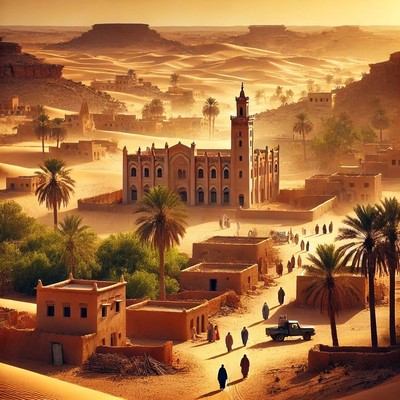
Day 8
Kiffa
Kiffa, the capital of the Assaba region, is a small but culturally significant town in southern Mauritania. Known for its traditional craftsmanship, desert landscapes, and unique local culture, Kiffa offers travelers an opportunity to experience authentic Saharan life away from mainstream tourism.
1. Discover Kiffa Beads – A Unique Mauritanian Craft
- Kiffa is world-famous for its handcrafted glass beads, known as Kiffa beads.
- These intricately designed, colorful beads were traditionally made by women using powdered glass and a unique firing technique.
- Though the craft is declining, some artisans still make and sell these beads in local markets.
- Visit a workshop to see the process and buy authentic Kiffa beads as a souvenir.
2. Explore the Local Market (Souk)
- Kiffa’s lively market is the heart of local trade.
- Shop for handmade crafts, spices, fresh dates, and traditional Mauritanian fabrics.
- A great place to observe daily life and interact with friendly locals.
3. Visit the Kiffa Mosque
- The town’s main mosque is a simple yet beautiful structure, reflecting traditional Sahelian architecture.
- It serves as a central gathering place for the community and is worth a quick visit.
4. Hike the Assaba Mountains
- Kiffa is surrounded by the Assaba Mountains, offering scenic views and great hiking opportunities.
- These rocky hills and plateaus provide a perfect backdrop for adventure seekers.
- The best time for hiking is early morning or late afternoon to avoid the desert heat.
5. Visit the Seasonal Salt Flats (Sebkhas)
- The area around Kiffa features seasonal salt flats, which appear after heavy rains.
- These shimmering white landscapes contrast beautifully with the red desert soil.
- A great spot for photography and desert exploration.
6. Experience a Traditional Tea Ceremony
- Like in all of Mauritania, mint tea is a central part of hospitality in Kiffa.
- Join locals in a three-cup tea ritual, where tea is poured high into glasses to create foam.
- This is a great way to connect with local people and experience Mauritanian culture firsthand.
7. Take a Camel Trek into the Surrounding Desert
- Arrange a camel trek to explore the semi-desert terrain around Kiffa.
- Meet local nomadic herders, who live in traditional desert tents.
- Multi-day treks allow travelers to camp under the stars and experience life in the Mauritanian wilderness.
8. Visit the Town of Barkéol (Day Trip Option)
- Located about 100 km from Kiffa, Barkéol is a small town known for its traditional mud-brick houses and ancient wells.
- It offers a glimpse into old caravan routes and life in rural Mauritania.
9. Attend a Local Festival or Celebration (If You’re Lucky!)
- Kiffa sometimes hosts cultural festivals with traditional Mauritanian music, poetry, and dance.
- Horse and camel races are popular at such events, showcasing Saharan equestrian skills.
- These gatherings provide a rare opportunity to experience authentic Mauritanian traditions.
10. Try Local Cuisine
- Kiffa is known for its simple but flavorful food, often influenced by Fulani and Moorish traditions.
- Try dishes like:
- Thieboudienne – Fish and rice, the national dish of Mauritania.
- Mechoui – Slow-roasted lamb, popular in desert regions.
- Lakh – A porridge made with millet, a staple food in the region.
How to Get to Kiffa
- Kiffa is located about 600 km from Nouakchott and can be reached by bus or shared taxi.
- The journey takes 8-10 hours, passing through the semi-desert landscape of central Mauritania.
- The town has basic accommodations, but it is best for adventurous travelers who enjoy off-the-grid experiences.
Final Thoughts
Kiffa is a hidden gem for culture lovers and adventure seekers, offering an authentic taste of Mauritanian life. Whether you’re exploring traditional bead-making, hiking the Assaba mountains, or riding camels into the desert, this town is a perfect stop for those looking to experience the heart of Mauritania’s rich traditions.
